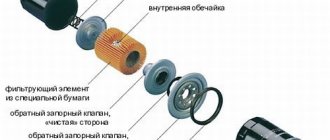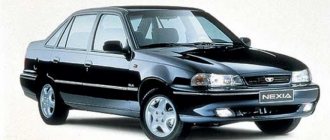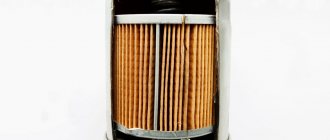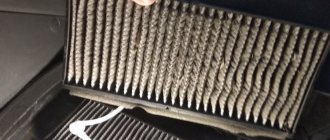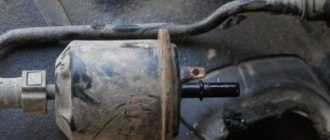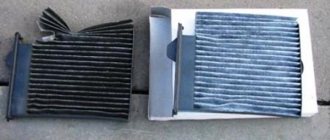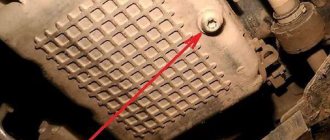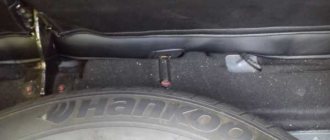Toyota Corolla is the owner of many titles: it is at the same time one of the oldest brands in the plant’s series (the first generation was released in 1966), and the holder of the Guinness record as the best-selling car in the world - the number of Corollas sold in 2000 exceeded 25 million. Then in just 6 years this number increased by another 10 million - you must admit, it is simply impossible to deny the popularity of this car.
On our roads, the most frequent guest is the Corolla in 120 (2000-2007) and 150 (2008-2012) bodies. These cars still demonstrate a good level of comfort and equipment, while their price on the secondary market is quite affordable, and maintenance is not difficult - by replacing the cabin filter on a Toyota Corolla yourself, you will spend only a couple of minutes, and you will not need any tools for this.
Importance of the filter element
The filter prevents the following from entering the cabin:
- asphalt particles;
- dust;
- pollen;
- road salts;
- dispute;
- pieces of leaves, etc.
The permeability of this element ensures air exchange in the cabin.
Cabin filter replacement frequency
The Toyota Corolla manufacturer indicates the desirability of changing the cabin filter every 20 thousand km. However, this frequency is only sufficient on good roads. In Russian conditions, to maintain normal air exchange in the cabin, it is recommended to install a new element every 10 thousand km.
It should be changed less often if the car is used in the northern regions of the country, where low temperatures last longer and there is a small amount of dust in the air.
In the southern steppe regions, the procedure must be performed more often due to the high rate of clogging. Strong winds are common here, lifting a lot of small debris into the air.
The fact that it is time to replace the dust-retaining element is indicated by a persistent unpleasant odor inside the car, the rapid appearance of a layer of dust on surfaces, and a decrease in the intensity of the air flow. Fogging of windows also indicates the need to perform the procedure.
What are car filters?
All salon cleaners can be divided into two types: anti-dust and carbon. Anti-dust devices are a rectangle of cellulose or synthetic fiber corrugated paper laid in rows. The fiber, in addition to dust particles, is capable of retaining soot, pollen, and heavy compounds. The paper on some models is pre-treated with chlorine and can prevent the spread of bacteria.
Anti-dust cabin filter
The coal version is a more “advanced” continuation of the anti-dust ones. The filter fiber in it contains particles of molded carbon, which, as is known, is an excellent absorbent. The cleaning element of the carbon filter is characterized by a higher density and is capable of trapping the smallest particles, such as nitrogen and sulfur oxides, benzenes and phenols. These carcinogens are very dangerous to human health and can cause the development of diseases of the respiratory system. When carcinogens interact with coal, coal particles absorb them and partially neutralize them.
Criterias of choice
The filter must be the correct size for the car's socket. Dimensions may vary slightly depending on the year of manufacture and manufacturer. If a parameter mismatch is detected, the element cannot be installed. Standard options are suitable for Toyota Corolla, marked with article number 87139-YZZ07. Coal models mounted on this vehicle are designated No. 88568-52010.
Pros of a carbon filter
Carbon models have a layer of activated carbon. It blocks not only dust particles, but also vapors:
- sulfur dioxide;
- benzene;
- ozone;
- carbon monoxide, etc.
The carbon version is capable of trapping many harmful compounds that make up exhaust gases, as well as trapping unpleasant odors. It is believed that pathogenic microorganisms cannot multiply in it.
Article number and cost of the original cabin filter for Corolla 150 and its analogues
Filters with different catalog numbers are installed on the Toyota Corolla 150 car. The article number depends both on the country to which the machine is produced for export, and on the year of its manufacture. At the same time, replaceable filter cartridges are completely interchangeable. The cost of branded standard filter elements ranges from 450 to 800 rubles. The article numbers for cabin filters are presented below:
- 8713952020;
- 87139YZZ20;
In addition to the original filter for the Toyota Corolla 150, a number of analogs are produced from third-party manufacturers. The best of them are summarized in the table below.
Table - Analogues of the cabin filter for Corolla 150
| Manufacturer | vendor code | Cost, ruble |
| Sakura | CAC1112 | 280-320 |
| Knecht-Mahle | LA395 | 300-350 |
| Starline | SFKF9470 | 200-220 |
| Blue Print | ADT32514 | 240-260 |
| Denso | DCC1007 | 360-400 |
| Parts-Mall | PMF081 | 180-200 |
| Masuma | MC2038 | 300-340 |
The Toyota Corolla 150 also uses a carbon filter. Its cost is from 700 to 1200 rubles. The article numbers of original carbon filters installed on cars are given below:
- 8713902020;
- 87139YZZ16;
- 17801YZZ06;
- 0897400820;
- 8713906080;
- 8713950100;
- 87139YZZ08;
- 87139YZZ10.
Third-party manufacturers produce analogues of branded coal products, which are not inferior to the original in terms of performance characteristics and quality. A list of the best brands is given in the table below.
Table - Analogues of the carbon filter on the Corolla 150
| Firm | Article number | Approximate cost, ruble |
| Nipparts | J1342027 | 320-370 |
| Blue Print | ADT32522 | 240-280 |
| Profit | 15203112 | 220-260 |
| Parts-Mall | PMF077 | 200-280 |
| Japan Parts | FAATY13 | 140-200 |
| Brother Star | XDK113 | 160-1900 |
| Interparts | IPCA107 | 190-240 |
Step-by-step instructions for replacing the cabin filter on a Toyota Corolla
The process of replacing the cabin filter on a Toyota Corolla has some peculiarities. You should remove all items stored in the glove compartment. If you need to change the filter element in winter, it is recommended to warm up the interior, because After freezing, plastic becomes brittle and can break during manipulation.
The glove compartment should be opened and pressed on its sides to release the stops. The cover is removed from the grooves on the lower mount. This will allow you to access the panel. It is secured with latches, so it is easy to remove.
Then you need to carefully remove the used element so that the debris that has accumulated on it does not fall onto the furnace fan. Be sure to compare the old and new elements. Their dimensions must match.
After this, you need to clean the air duct of dust and seeds that have fallen inside. You can use a soft brush. A new element is inserted into the socket. Then, carefully, so as not to damage the latches, mount the protective panel back. Only after this can the glove compartment be installed.
Cabin filter location
The cabin filter on the Corolla 150 is located directly behind the glove compartment on the passenger side. Unlike previous Toyota models, the filter does not have a special frame, but is installed in the body.
Cabin filter location
The filter element is located in the path of the air flow, which enters the radiators of the stove and air conditioner. For this reason, it has a direct impact on creating a comfortable climate inside the car.
Replacing the filter yourself
The lower loop of the stop is attached here.
If you have “correctly growing” hands, replacing the cabin filtration element of a Toyota Corolla is not difficult at all. Before you change the cabin filter on your Corolla 150 yourself, empty the glove box.
Algorithm for replacing the cabin absorber:
- Empty the glove compartment;
- If replacing in the cold season, it is better to pre-warm the car, since cold plastic is fragile and therefore often cracks when pressed;
- To dismantle the glove compartment, carefully move the side walls and open the fixing elements of the drawer pull-out;
- Remove the glove compartment from the hook-shaped fasteners at the bottom of the glove compartment;
- Behind it is a cover covering the cabin filter. To remove the part, simply press down on the side clips attached to the body
- Take out the anti-dust element. Avoid getting debris into the air duct and heating fan, perform the manipulation very carefully, without pulling the filter with force;
- Insert a new filter.
Attach the support leg to the glove box
After completing the installation of the new absorber, fasten the filter cover, and then assemble the glove box back.
Choosing the right filter
Before you think about the correct installation of the purifier, you must first purchase it. We recommend purchasing filters and other auto parts from official Toyota dealers. Of course, the price at the dealership will be higher than if you bought it at a regular store, but products purchased at authorized retail outlets are covered by the manufacturer's warranty.
To make the right choice of filter, you need to know the make of your Toyota engine, year of manufacture and chassis number. All this information can be gleaned from the state registration certificate of the car. Based on this data, use the catalog - finding the right product will not be difficult. If you have any questions regarding your selection, please contact the store consultants.
Why do most car owners prefer carbon filters?
Structurally, the cabin filter can consist of several layers, but in the case of the carbon version, it includes activated carbon, which is capable of absorbing chemical compounds at the molecular level. Thus, you protect yourself from any harmful substances present in exhaust gases, which is important in many cases (when driving in traffic jams, in tunnels, near polluted industrial zones, livestock farms and other similar places). Advantages of using carbon filter elements:
- when driving in congested conditions, you can use a fan or car air conditioner without any problems (there is no need to turn on the recirculation mode);
- an uncontaminated carbon filter helps reduce glass fogging;
- the level of air purification increases to 95-98%;
- the interior is completely protected from the penetration of external odors and volatile chemicals harmful to health.
Consumable replacement time
While doing its job, the cabin filter part becomes clogged with dust, dirt, pollen over time; insects can get into it in the summer and fallen leaves in the fall. Therefore, it is important to change the “stuffing” of the ventilation system on time.
According to the data specified in the manufacturer's operating manual, the filtration part in a Toyota car must be replaced with a new one after 20,000 km, that is, during every second maintenance. But there are nuances:
- if the car is rarely used, it is recommended to change this part at least once a year, even if the cherished 20,000 km on the meter have not yet reached;
- if the car is used more often for driving around the city, it is worth reducing the figure to 10,000 km and changing the cabin filter earlier than the manufacturer advises. Constantly being in the flow of other cars contributes to increased load during the filtration process due to the large number of microparticles of soot from exhaust gases and dust raised by tires from the road;
- when the machine is operated most of the time at low air temperatures (northern region), the filter element can be changed less frequently - there are no major pollutants;
- areas with a warm climate, on the contrary, require more frequent replacement: this is affected by insects, a large amount of dust, fluff and pollen during the flowering period;
- those who drive on roads near black soil will have to buy new consumables less often, but the more common sandy loam soils contribute to the rapid deterioration of the filter element;
- People with hypersensitivity to air quality and allergies to dust or fluff are recommended to change this part as often as possible.
How often should I replace it?
In accordance with the manufacturer's regulations, the cleaning element is updated every scheduled maintenance - after 20,000 km .
For CIS countries, it is rational to reduce the replacement interval to 10,000 km. We take into account the level of dust and gas pollution in regions and megacities. In summer, the resource is reduced by fallen leaves and poplar fluff, which is absorbed by the air flow. In winter there is excess moisture, which contributes to the emergence and development of pathogenic bacteria.
Most motorists follow the recommendations in the operating instructions, which is also true.

